Exploring the intricate landscape of Feline Leukemia (FeLV) unveils a world where knowledge becomes a shield against unseen threats to our feline companions.
From the silent pathways of transmission to the diagnostic intricacies that unravel the virus's presence, each element plays a crucial role in safeguarding the well-being of our beloved cats.
As we navigate through the realms of prevention, diagnosis, and management of FeLV, a deeper understanding emerges, shedding light on the importance of informed decisions in protecting our furry friends.
Key Takeaways
- FeLV spreads through bodily fluids and can be transmitted through grooming, bites, and mother-to-kitten contact.
- Symptoms of FeLV include lethargy, weight loss, poor appetite, and various other health issues.
- Testing is crucial for FeLV detection, with ELISA being a common method; early diagnosis can aid in management.
- Prevention involves regular vet check-ups, indoor living, vaccinations, and spaying/neutering to reduce transmission risks.
FeLV Transmission and Contagiousness
Feline Leukemia (FeLV) is transmitted through various bodily fluids such as blood, saliva, and nasal secretions, making it contagious among cats through bite wounds, grooming, and from mother cats to kittens. FeLV can be passed between cats even if the infected cat appears healthy, emphasizing the importance of preventive measures.
It is crucial to note that FeLV is not transmissible to humans, dogs, or other animals. While less common, shared resources like food and water bowls can also serve as a potential source of transmission. Understanding how FeLV spreads underscores the necessity of responsible pet ownership, regular vet check-ups, and proactive testing to protect the feline population from this viral infection.
Signs and Symptoms of FeLV
Manifesting in various forms, the signs and symptoms of FeLV serve as crucial indicators of the viral infection's impact on affected felines. Some key signs and symptoms include:
- Lethargy
- Weight loss
- Poor appetite
- Fever
- Behavioral changes
These manifestations may vary in severity and can indicate different stages of the disease. It is essential for cat owners to be vigilant and seek veterinary care if they notice any of these symptoms in their feline companions.
Early detection and management of FeLV-related signs can significantly impact the quality of life and overall well-being of the affected cat.
Testing for Feline Leukemia
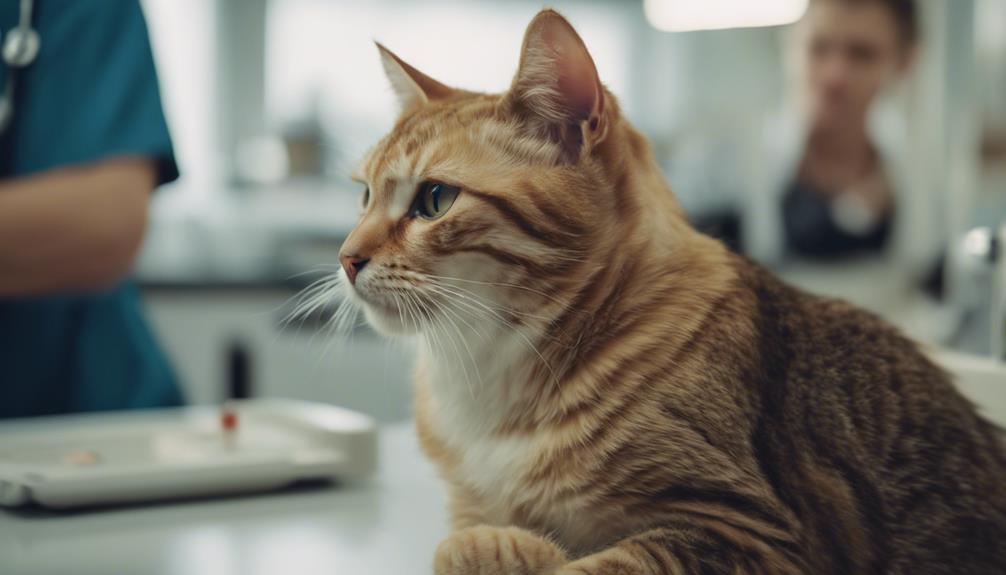
Early and accurate diagnosis of feline leukemia is crucial for effective management and care of affected cats. Testing for FeLV is essential, especially in cats showing symptoms or before introducing them to a new environment. The Enzyme-linked immunosorbent assay (ELISA) is commonly used to detect the FeLV P27 protein, but additional tests like PCR, virus isolation, and IFA may be needed for confirmation. Cats should ideally be tested 30 days post-exposure to avoid false negatives. Below is a table outlining different testing methods for Feline Leukemia:
| Test Type | Description |
|---|---|
| ELISA | Detects FeLV P27 protein |
| PCR | Polymerase chain reaction for FeLV DNA |
| Virus Isolation | Cultures the virus to confirm infection |
These tests help in accurately diagnosing FeLV and guiding appropriate care for affected cats.
Diagnosis Methods for FeLV
For accurate identification of Feline Leukemia (FeLV) infection in cats, various diagnostic methods are employed to confirm the presence of the virus. These methods include:
- Enzyme-linked immunosorbent assay (ELISA) to detect FeLV P27 protein.
- Polymerase chain reaction (PCR) testing to amplify and detect FeLV genetic material.
- Virus isolation to grow and identify the virus in a lab setting.
- Immunofluorescence assay (IFA) to detect FeLV antigens in blood cells.
- Sequential testing over time to confirm persistent infection.
Treatment Approaches for FeLV
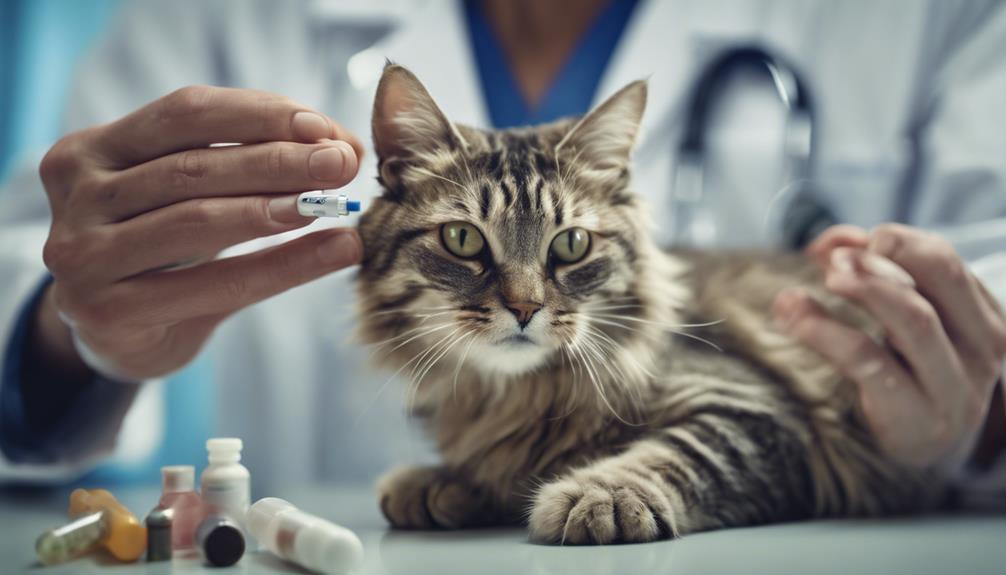
To effectively address Feline Leukemia (FeLV), the focus shifts towards exploring treatment approaches that aim to manage symptoms and improve the quality of life for infected cats. These approaches include providing supportive care, managing secondary infections, and monitoring overall health. Here is a breakdown of some common treatment strategies:
| Treatment Approaches | Description |
|---|---|
| Supportive Care | Providing a comfortable environment and proper nutrition. |
| Monitoring | Regular check-ups to assess overall health and organ function. |
| Managing Infections | Addressing secondary infections promptly to prevent complications. |
| Vaccinations | Ensuring up-to-date vaccinations to prevent other illnesses. |
| Medication | Administering medications to alleviate symptoms and improve quality of life. |
Managing FeLV Symptoms
Effective management of Feline Leukemia (FeLV) symptoms is crucial for maintaining the well-being of infected cats. When dealing with FeLV-positive cats, here are some key strategies to help manage their symptoms:
- Providing a balanced and nutritious diet tailored to their needs.
- Ensuring a stress-free environment to support their immune system.
- Regular veterinary check-ups to monitor their health status.
- Prompt treatment of any secondary infections that may arise.
- Offering love, care, and attention to improve their overall quality of life.
Preventive Care for FeLV
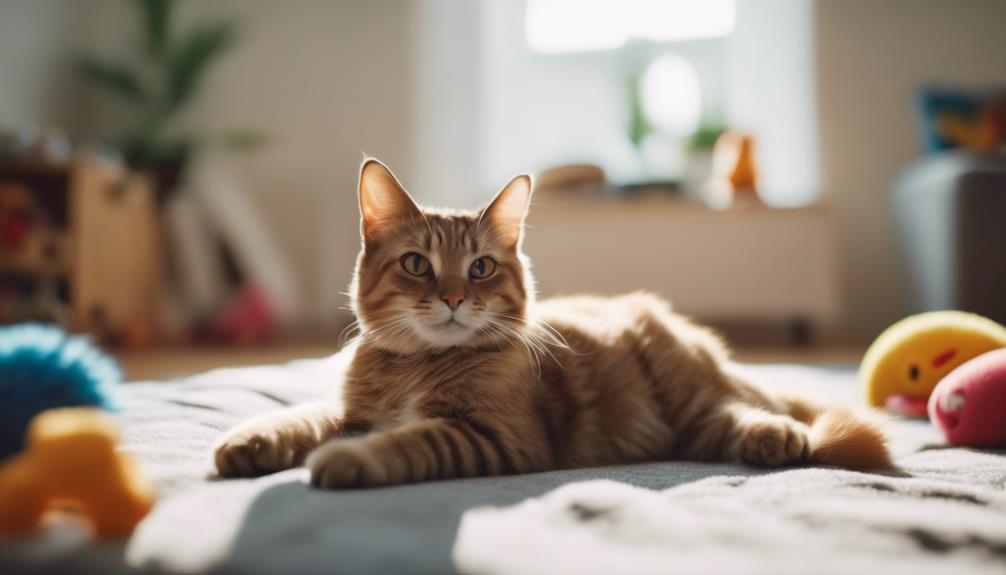
When considering the management of Feline Leukemia (FeLV) in infected cats, a crucial aspect involves implementing preventive care measures to minimize the risk of disease transmission and enhance overall well-being. Preventive care for FeLV-positive cats includes regular veterinary check-ups, indoor living to reduce exposure to potential pathogens, parasite preventives to maintain overall health, and vaccinations to protect against other diseases.
Additionally, monitoring the cat's weight, behavior changes, and organ function is essential to catch any potential issues early. Spaying or neutering your FeLV-positive cat can also help prevent stress-related complications and reduce the risk of disease transmission.
Controlling FeLV Spread
Implementing stringent control measures is essential for minimizing the spread of Feline Leukemia (FeLV) among cats in various environments. To effectively control the spread of FeLV, consider the following strategies:
- Regular Testing: Ensure all cats are tested before introducing them to a new environment.
- Indoor Living: Keeping cats indoors reduces the risk of exposure to FeLV-infected cats.
- Vaccinations: Ensure all cats are up-to-date on their vaccinations to boost their immune response.
- Healthy Living: Maintain cats' overall health through regular vet check-ups, proper nutrition, and preventive care.
- Isolation of Infected Cats: Keep infected cats separated from healthy cats to prevent transmission.
Risk Factors for FeLV
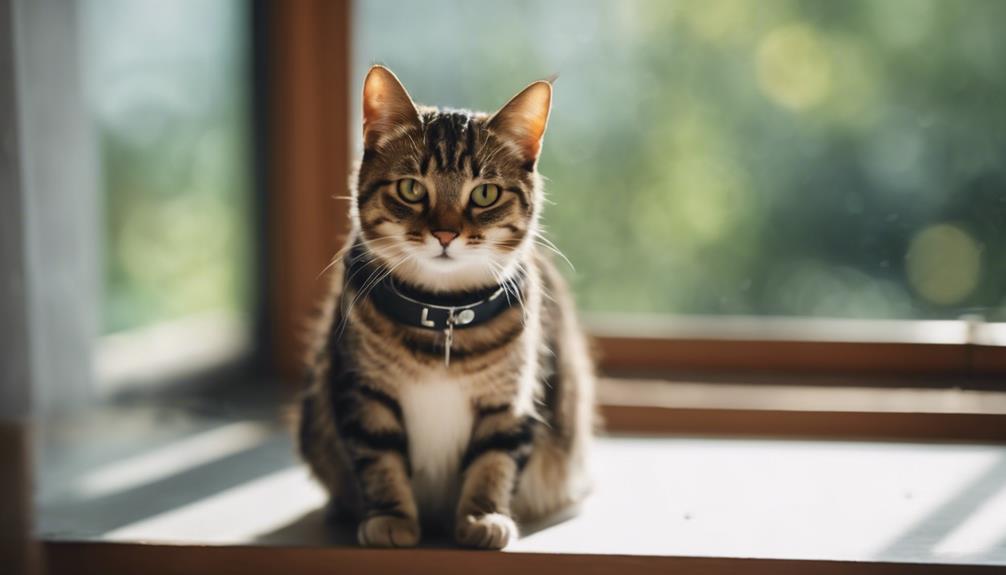
Identifying the key risk factors associated with Feline Leukemia (FeLV) transmission is crucial for implementing targeted preventive measures. Outdoor cats have a higher risk due to increased exposure to infected cats and environments. Kittens born to FeLV-positive mothers are at significant risk of contracting the virus.
Cats that engage in aggressive behavior leading to bite wounds are more susceptible to FeLV transmission. Additionally, cats living in multi-cat households or shelters where there is close contact have an elevated risk. Sharing food and water bowls can also facilitate virus transmission.
Understanding these risk factors is essential for developing effective strategies to prevent the spread of FeLV and protect the feline population.
FeLV Testing Guidelines
The FeLV testing guidelines outline essential procedures for accurately diagnosing feline leukemia in cats. When it comes to testing for FeLV, here are some key guidelines to keep in mind:
- Testing should be conducted before introducing a new cat to a household.
- The Enzyme-linked immunosorbent assay (ELISA) test is commonly used to detect FeLV P27 protein.
- Testing ideally should be performed 30 days post-exposure to avoid false negatives.
- Additional tests such as PCR, virus isolation, and IFA can help confirm FeLV infection.
- Cats that have cleared the infection will test negative in future screenings.
Lifestyle Modifications for FeLV
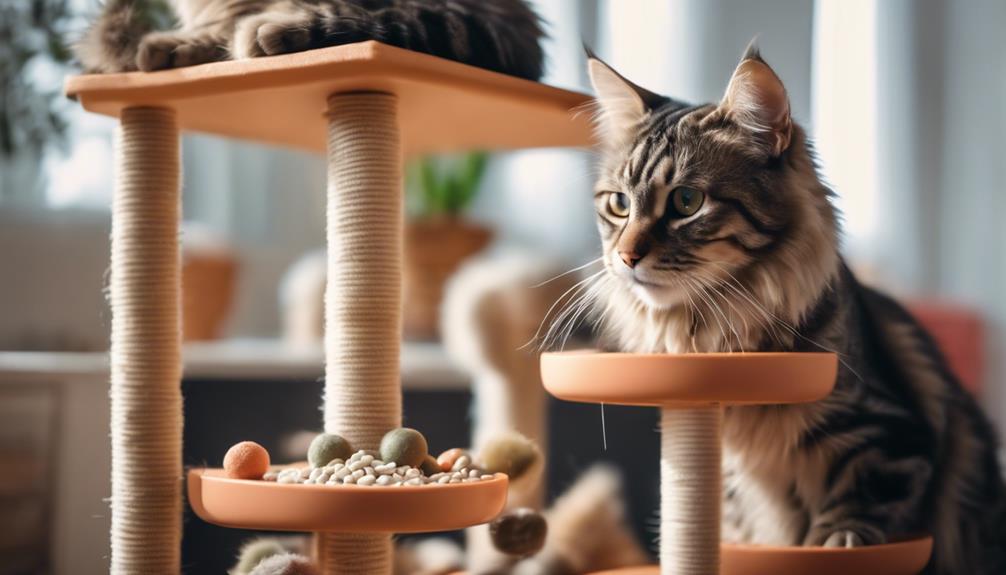
Effective management of feline leukemia involves adapting the daily routines and environment of infected cats to enhance their overall well-being and longevity. FeLV-positive cats benefit from a stress-free, indoor environment to minimize exposure to potential infections and reduce their risk of injury.
Providing a balanced diet, regular veterinary check-ups, and a comfortable living space can improve their quality of life. Ensuring access to clean water, nutritious food, and a cozy resting area is essential. Additionally, creating a predictable routine for feeding, playtime, and rest can help reduce anxiety in FeLV-positive cats.
Monitoring FeLV-Positive Cats
Regular surveillance and observation of FeLV-positive cats is essential for ensuring their health and well-being. To effectively monitor these cats, consider the following:
- Regular Veterinary Check-ups: Schedule frequent visits to assess their overall health status.
- Weight Monitoring: Keep track of their weight to detect any sudden changes.
- Behavioral Observations: Watch for any changes in behavior or activity levels.
- Organ Function Tests: Periodically conduct tests to evaluate the function of vital organs.
- Environmental Enrichment: Provide a stimulating environment to maintain their mental and physical well-being.
Reproductive Health in FeLV Cats
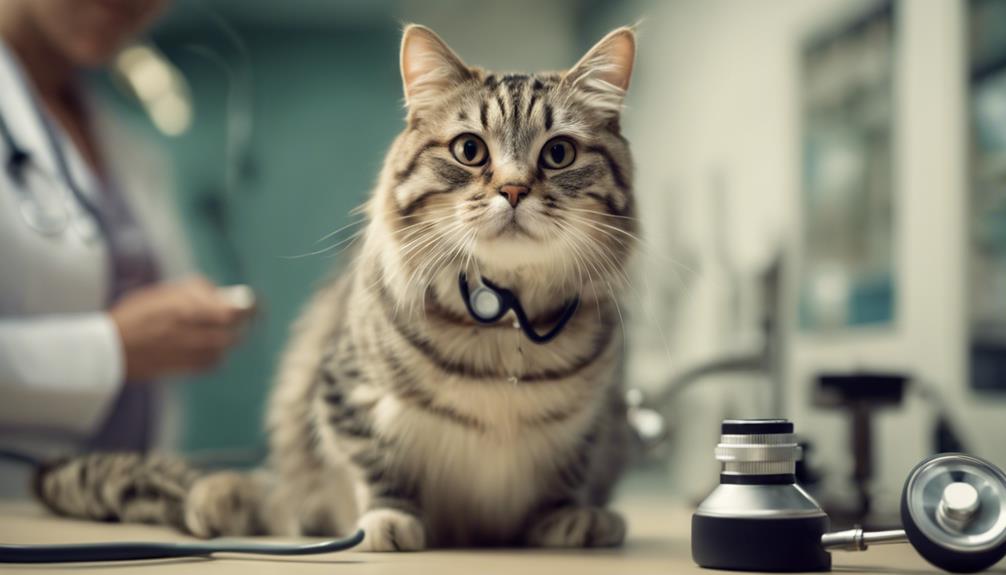
Maintaining optimal reproductive health in cats diagnosed with Feline Leukemia (FeLV) requires specialized care and considerations. FeLV-positive cats may experience reproductive challenges, including infertility and pregnancy complications.
Spaying and neutering are recommended to prevent stress and reduce the risk of disease transmission. These procedures also help control the cat population and limit the spread of FeLV.
Additionally, reproductive health in FeLV cats should involve regular monitoring by a veterinarian to address any emerging issues promptly. Ensuring a safe and comfortable environment for the cat is crucial for their overall well-being.
Vaccination Considerations for FeLV
When considering vaccination for Feline Leukemia (FeLV), it is essential to understand the role of preventive measures in managing the health of cats at risk.
- Consult Your Veterinarian: Seek professional advice on the necessity of FeLV vaccination for your cat.
- Vaccination Schedule: Follow the recommended vaccination schedule tailored to your cat's lifestyle and risk factors.
- Monitor for Side Effects: Keep an eye out for any adverse reactions post-vaccination and inform your vet promptly.
- Regular Boosters: Stay up-to-date with booster shots as advised to ensure continued immunity.
- Environmental Management: Implement measures to reduce exposure to FeLV by keeping your cat indoors and away from potentially infected felines.
Frequently Asked Questions
Can Felv-Positive Cats Safely Live With Felv-Negative Cats?
FeLV-positive cats should not live with FeLV-negative cats due to the risk of transmission. Separation is crucial to prevent contagion. Consult a veterinarian for tailored advice on managing FeLV-positive felines and safeguarding their health.
Are There Any Specific Dietary Recommendations for Felv-Positive Cats?
For FeLV-positive cats, a diet rich in high-quality protein and essential nutrients is vital. Consider feeding them balanced commercial cat foods or consult a vet for tailored dietary recommendations. Hydration is crucial.
How Does Stress Impact the Health of Cats With Feline Leukemia?
Stress can worsen the health of cats with feline leukemia by compromising their immune system, leading to increased susceptibility to infections and disease progression. Minimizing stress through a stable environment and routine care is vital for their well-being.
Is It Possible for Felv-Positive Cats to Go Into Remission?
Feline leukemia-positive cats can go into remission, but it's rare. Remission may be temporary or permanent. Regular monitoring, vet care, and a stress-free environment are crucial. Each case varies; consult with a veterinarian for tailored guidance.
Are There Any Alternative or Complementary Therapies That Can Help Manage Felv Symptoms?
Alternative and complementary therapies for managing FeLV symptoms may include supplements like L-lysine, immune-boosting herbs, and acupuncture. However, these should be used in conjunction with traditional veterinary care. Always consult a veterinarian for the best approach.
Conclusion
In conclusion, understanding the transmission, signs, testing, diagnosis, treatment, and preventive measures for Feline Leukemia (FeLV) is crucial for cat owners and caregivers.
By being knowledgeable about the complexities of this viral infection, individuals can better protect their feline companions and ensure their health and well-being.
Through proactive preventive care, early detection, and vigilant monitoring, the risks associated with FeLV can be minimized, ultimately leading to improved outcomes for affected cats.




